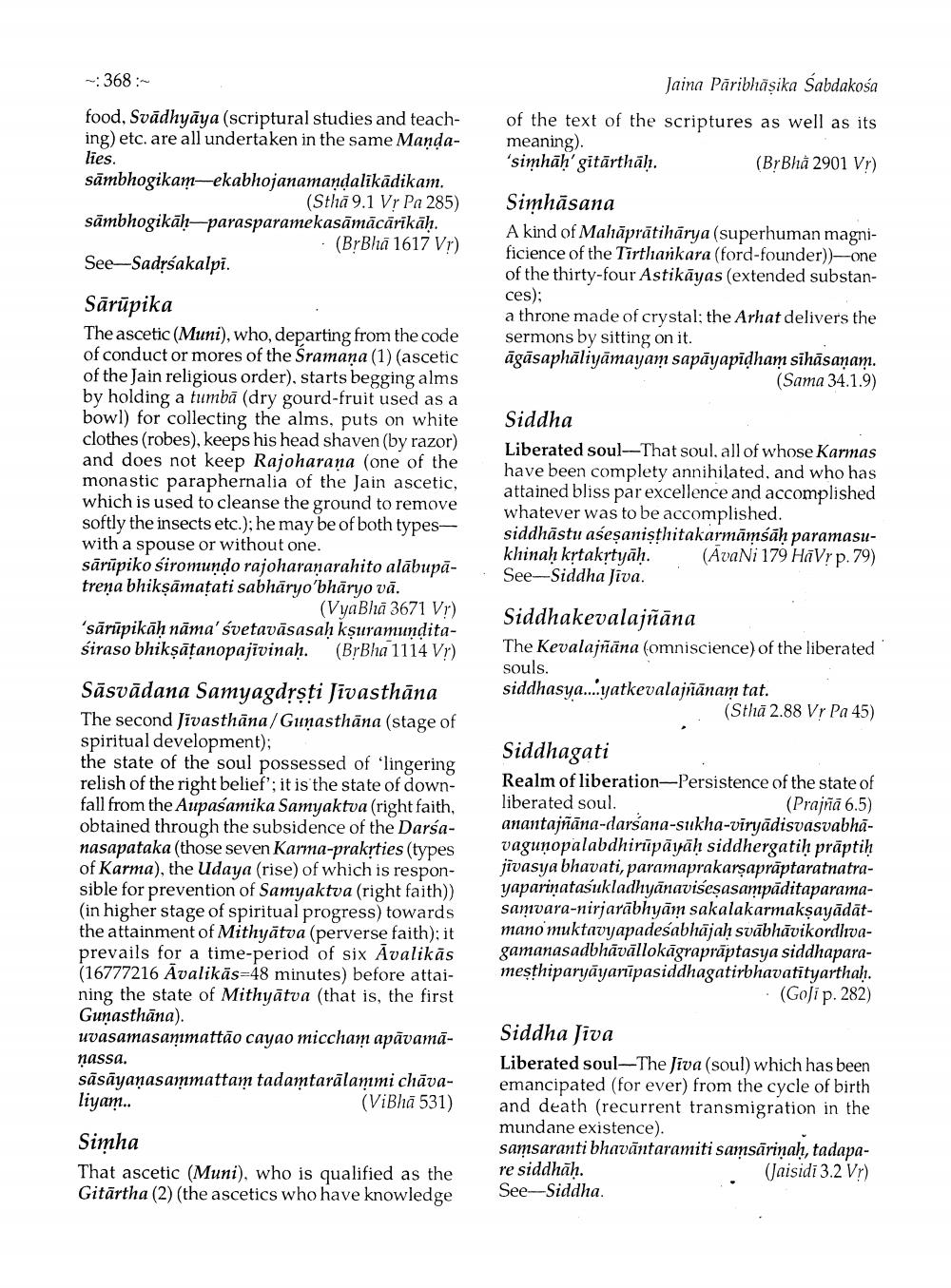________________
~:368
food, Svadhyaya (scriptural studies and teaching) etc. are all undertaken in the same Mandalies.
sambhogikam―ekabhojanamaṇḍalīkādikam.
(Stha 9.1 Vr Pa 285) sambhogikāḥ parasparamekasāmācārikāḥ, (BrBha 1617 VT)
See-Sadṛśakalpi.
Sārūpika
The ascetic (Muni), who, departing from the code of conduct or mores of the Sramana (1) (ascetic of the Jain religious order). starts begging alms by holding a fiomba (dry gourd-fruit used as a bowl) for collecting the alms, puts on white clothes (robes), keeps his head shaven (by razor) and does not keep Rajoharana (one of the monastic paraphernalia of the Jain ascetic, which is used to cleanse the ground to remove softly the insects etc.); he may be of both typeswith a spouse or without one. säripiko siromando rajoharaṇarahito alabupătrena bhikṣāmatati sabhäryo bharyo vā. (VyaBha 3671 Vr) 'sarūpikāḥ näma' svetavāsasaḥ kṣuramunditasiraso bhikṣatanopajivinaḥ. (BrBha 1114 Vr)
Såsvädana Samyagdṛṣṭi Jivasthana The second Jivasthana/Gunasthana (stage of spiritual development);
the state of the soul possessed of 'lingering relish of the right belief'; it is the state of downfall from the Aupasamika Samyaktva (right faith, obtained through the subsidence of the Darsanasapataka (those seven Karma-prakṛties (types of Karma), the Udaya (rise) of which is responsible for prevention of Samyaktva (right faith)) (in higher stage of spiritual progress) towards the attainment of Mithyätva (perverse faith); it prevails for a time-period of six Avalikäs (16777216 Avalikās-48 minutes) before attaining the state of Mithyatva (that is, the first Gunasthana).
uvasamasanmattão cayao miccham apavama
nassa.
sāsāyaṇasammattam tadamtaralammi chāva(ViBhā 531)
liyam..
Simha
That ascetic (Muni), who is qualified as the Gitärtha (2) (the ascetics who have knowledge
Jaina Paribhāṣika Sabdakośa
of the text of the scriptures as well as its meaning). 'simhah' gitarthaḥ, (BrBhá 2901 Vr)
Simhasana
A kind of Mahapratihärya (superhuman magnificience of the Tirthankara (ford-founder))-one of the thirty-four Astikäyas (extended substances);
a throne made of crystal: the Arhat delivers the sermons by sitting on it. ägäsaphaliyamayam sapayapiḍham sihasanam. (Sama 34.1.9)
Siddha
Liberated soul-That soul, all of whose Karmas have been complety annihilated, and who has attained bliss par excellence and accomplished whatever was to be accomplished. siddhästu asesanisthitakarmansäḥ paramasukhinah krtakṛtyäḥ. (AvaNi 179 HaVṛ p.79) See-Siddha Jiva.
Siddhakevalajñāna
The Kevalajñāna (omniscience) of the liberated souls. siddhasya....yatkevalajñānam tat.
(Stha 2.88 Vr Pa 45)
Siddhagati
Realm of liberation-Persistence of the state of liberated soul. (Prina 6.5)
anantajana-darśana-sukha-viryddisvasvabhi
vagunopalabdhirüpäydḥ siddhergatiḥ präptik jivasya bhavati, paramaprakarṣaprāptaratnatra
yaparinatasukladhyanaviseṣasampaditaparama
samvara-nirjarabhyan sakalakarmakṣayādātmano muktavyapadeśabhājah svabhävikordivagamanasadbhavallokagrapnäptasya siddhaparamesthiparyayaripasiddhagatirbhavatityarthal.
(Goli p. 282)
Siddha Jiva
Liberated soul-The Jiva (soul) which has been emancipated (for ever) from the cycle of birth and death (recurrent transmigration in the mundane existence). samsaranti bhaväntaramiti samsariṇaḥ, tadapare siddhäh. (Jaisidi 3.2 Vr) See-Siddha.




